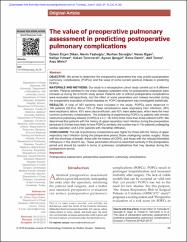The value of preoperative pulmonary assessment in predicting postoperative pulmonary complications

Göster/
Erişim
info:eu-repo/semantics/openAccessTarih
2019Yazar
Diken, Özlem ErçenFazlıoğlu, Nevin
Sarıoğlu, Nurhan
Ogan, Nalan
Yılmaz, Nafiye
Tanrıverdi, Hakan
Şengül, Aysun
Demir, Emre
Turna, Akif
Mirici, Arzu
Üst veri
Tüm öğe kaydını gösterÖzet
OBJECTIVE: We aimed to determine the preoperative parameters that may predict postoperative pulmonary complications (POPCs) and the value of some current practical indexes in predicting POPCs.
MATERIALS and METHODS: Our study is a retrospective cohort study carried out in 9 different centers. Patients admitted to the chest diseases outpatient clinic for preoperative evaluation were followed up during the 6-month study period. Patients with or without postoperative complications were evaluated retrospectively, and the effect of some parameters and indexes recorded during the preoperative evaluation of chest diseases on POPC development was investigated statistically.
RESULTS: A total of 307 patients were included in the study. POPCs were observed in 100 patients (32.6%). About 13% of these complications were respiratory tract infections, 59% were respiratory failure, 45% were pleural effusion, and 42% were atelectasis, which were the most common pulmonary complications. The probability of experiencing POPCs by patients with chronic obstructive pulmonary disease (COPD) is 2.5 (1.18-5.67) times more than those without COPD. We determined that patients with the history of upper respiratory tract infection during the preoperative period are 5.3 times more likely to have POPCs; similarly, the number was 4.7 for patients undergoing cardiac operation and 3.3 for patients with interstitial infiltration.
CONCLUSION: The risk of pulmonary complications was higher for those with the history of upper respiratory tract infection during the preoperative period, those undergoing cardiac surgery, those with the shortness of breath, those with the history of COPD, and those with the reticular/interstitial infiltrations in the chest X-ray. These parameters should be examined carefully in the preoperative period and should be careful in terms of pulmonary complications that may develop during the postoperative period.

















